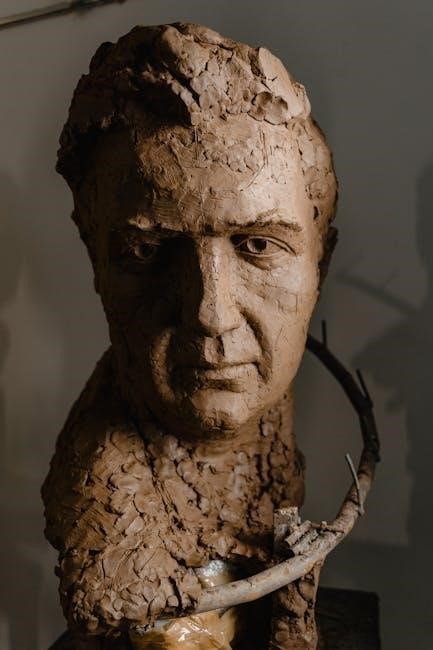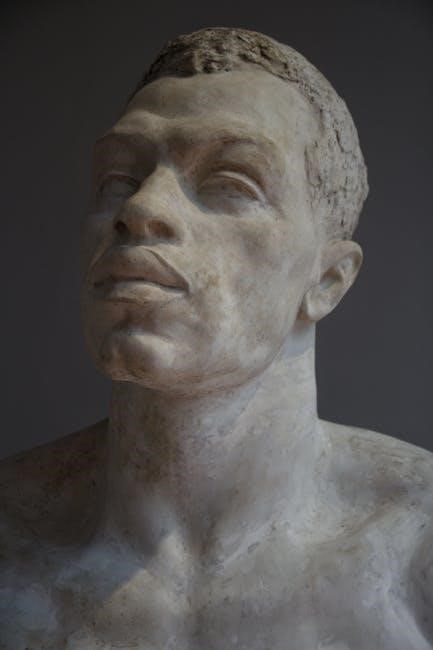Overview of Head and Neck Anatomy
The head and neck form a complex anatomical region connecting the brain to the body‚ comprising bones‚ muscles‚ nerves‚ and blood vessels essential for sensory and motor functions.
1.1 Importance of Head and Neck Anatomy in Medicine
Understanding head and neck anatomy is crucial for accurate diagnostics and treatments. It aids in identifying lymph node pathology‚ cranial nerve function‚ and surgical landmarks. This knowledge guides biopsies‚ cancer staging‚ and reconstructive surgeries‚ ensuring precise medical interventions. It also underpins radiological interpretations and informs clinical decision-making‚ making it fundamental for healthcare professionals to master.
1.2 Basic Structure and Regions of the Head and Neck
The head and neck are divided into distinct regions‚ including the cranial vault‚ face‚ cervical area‚ and thoracic inlet. The cranial vault houses the brain‚ while the face contains sensory organs. The neck connects the head to the torso‚ featuring vital structures like the thyroid gland‚ trachea‚ and cervical spine. These regions are interconnected‚ forming a functional unit essential for both voluntary and involuntary bodily functions.

Skeletal Structure of the Head and Neck
The skeletal framework includes the skull‚ mandible‚ maxilla‚ and cervical spine‚ providing structural support and protection for vital organs while enabling movement and function in the region.
2.1 Skull Bones and Their Functions
The skull consists of 22 bones‚ including 8 cranial bones and 14 facial bones. Cranial bones protect the brain‚ while facial bones form the orbits‚ nasal cavity‚ and jaw. Together‚ they provide structural support‚ facilitate sensory functions‚ and house vital organs. Their intricate arrangement ensures both protection and functionality‚ making them foundational to the head and neck structure.
2.2 Mandible and Maxilla: Key Facial Bones
The mandible‚ or lower jawbone‚ is the only movable facial bone‚ enabling chewing and speech. It connects to the skull via the temporomandibular joint (TMJ). The maxilla forms the upper jaw‚ housing the maxillary sinuses and contributing to the orbital floor. Both bones are vital for facial structure‚ supporting teeth‚ muscles‚ and nerves. Their intricate design facilitates functions like chewing‚ speaking‚ and maintaining aesthetic proportions of the face.
Muscles of the Head and Neck
The sternocleidomastoid muscle (SCM) is a key neck muscle aiding head rotation and tilting. It works with trapezius and others to maintain posture and enable complex movements.
3.1 Extrinsic Muscles of the Head (Scalene‚ Sternocleidomastoid)
The sternocleidomastoid (SCM) and scalene muscles are extrinsic muscles of the head and neck. The SCM facilitates head rotation‚ tilting‚ and flexion‚ while the scalene muscles assist in neck movements and respiration. These muscles are crucial for maintaining posture and enabling complex head and neck movements. Their functional anatomy is vital in clinical settings for surgeries and diagnosing pathologies.
3.2 Intrinsic Muscles of the Face and Neck
Intrinsic muscles of the face and neck control facial expressions and neck movements. They include the orbicularis oculi (eyelid closure) and orbicularis oris (lip movements). These muscles enable communication through expressions and support functions like chewing and speech. Their intricate network allows precise movements‚ making them vital for both voluntary and involuntary actions‚ while also playing a key role in clinical diagnostics and surgical procedures.

Nervous System of the Head and Neck
The nervous system of the head and neck includes cranial nerves controlling vision‚ hearing‚ and facial movements‚ along with cervical nerves regulating neck sensations and movements.
4.1 Cranial Nerves and Their Functions
Cranial nerves originate from the brainstem and regulate vital functions such as vision‚ hearing‚ taste‚ and facial movements. The trigeminal nerve manages facial sensation and chewing‚ while the facial nerve controls expressions and taste. The vestibulocochlear nerve handles hearing and balance. Cranial nerves VII-XII are essential for eye movements‚ swallowing‚ and speech‚ making them critical for sensory and motor activities in the head and neck region.
4.2 Cervical Plexus and Its Role
The cervical plexus is a network of nerves arising from cervical vertebrae C1-C4‚ playing a crucial role in neck and shoulder innervation. It supplies sensory nerves to the skin of the neck and behind the ears via the great auricular nerve. Motor branches innervate key muscles like the sternocleidomastoid and trapezius‚ essential for neck movements. This plexus also contributes to the phrenic nerve‚ vital for diaphragmatic function‚ highlighting its significance in both sensory and motor functions of the head and neck region.

Lymphatic Drainage of the Head and Neck
Lymphatic drainage in the head and neck involves a network of vessels and nodes‚ crucial for immune function and detecting pathogens‚ with significant clinical implications in pathology.
5.1 Lymph Nodes and Their Distribution
Lymph nodes in the head and neck are distributed in groups‚ including cervical‚ submandibular‚ and parotid nodes. These nodes play a vital role in filtering lymph fluid‚ aiding immune responses‚ and detecting infections or malignancies early. Their strategic placement facilitates effective drainage‚ making them critical in clinical assessments for conditions like cancer or infections.
5.2 Clinical Significance in Pathology
Lymph nodes in the head and neck are critical indicators in pathology‚ often reflecting infections‚ inflammation‚ or malignancies. Their enlargement or abnormalities can signal conditions like cancer‚ tuberculosis‚ or autoimmune diseases. Accurate assessment of these nodes aids in diagnosing and staging cancers‚ such as head and neck malignancies‚ influencing treatment plans and prognosis. Their role in immune surveillance makes them vital for early detection and clinical intervention.

Blood Vessels of the Head and Neck
The head and neck are supplied by major arteries like the carotid and vertebral arteries‚ ensuring blood flow to the brain and facial structures. The venous system‚ including jugular veins‚ facilitates blood return to the heart‚ playing a crucial role in clinical diagnostics and surgical interventions.
6.1 Arterial Supply (Carotid and Vertebral Arteries)
The carotid and vertebral arteries are the primary suppliers of oxygenated blood to the head and neck. The carotid arteries originate from the aorta and divide into internal and external branches‚ supplying the brain‚ face‚ and neck. The vertebral arteries arise from the subclavian arteries‚ ascending through the transverse foramina of the cervical vertebrae to join at the basilar artery‚ ensuring blood flow to the posterior brain and cervical structures. These arteries are critical for maintaining neurological function and are often focal points in surgical and diagnostic procedures.
6.2 Venous System and Its Significance
The venous system of the head and neck plays a vital role in draining deoxygenated blood back to the heart. Key veins include the jugular‚ facial‚ and retromandibular veins‚ which collect blood from facial structures‚ scalp‚ and neck tissues. This system is clinically significant in surgeries‚ as it influences procedures like neck dissections and is crucial for understanding pathological conditions such as thrombosis or venous malformations. Proper venous drainage ensures healthy tissue function and prevents complications.

Clinical Anatomy and Its Applications
Clinical anatomy focuses on the practical application of anatomical knowledge in diagnosis‚ treatment‚ and surgery. It bridges basic science with patient care‚ guiding medical interventions effectively.
7.1 Case Studies in Head and Neck Pathology
Case studies in head and neck pathology provide detailed insights into rare and complex conditions‚ such as thyroid nodules or cervical lymphadenopathy. These studies highlight anatomical structures involved and their clinical significance‚ aiding in diagnosis and treatment planning. By analyzing real-life scenarios‚ clinicians gain a deeper understanding of surgical approaches‚ radiological findings‚ and histopathological correlations‚ enhancing patient care and outcomes in head and neck surgery.
7.2 Surgical Landmarks and Procedures
Surgical landmarks in the head and neck‚ such as the mandible‚ sternocleidomastoid muscle‚ and cervical vertebrae‚ guide procedures like tracheostomy and neck dissection. Understanding these anatomical references is crucial for minimizing risks and ensuring precision. Surgeons rely on these landmarks to navigate complex structures‚ such as the carotid sheath and facial nerve branches‚ during operations. This knowledge is vital for safe and effective surgical interventions in the head and neck region.
Diagnostic Imaging of the Head and Neck
Diagnostic imaging‚ including MRI and CT scans‚ provides detailed visualization of head and neck structures‚ aiding in the detection of abnormalities and guiding treatment plans effectively.
8.1 MRI and CT Scan Techniques
MRI and CT scans are advanced imaging modalities used to visualize head and neck structures. MRI excels in detailing soft tissues‚ while CT scans provide clear images of bones and blood vessels. These techniques are essential for diagnosing abnormalities‚ such as tumors or fractures‚ and guide surgical interventions. High-resolution images enable precise anatomical assessments‚ making them invaluable in clinical diagnostics and treatment planning for complex head and neck conditions.
8.2 Radiological Anatomy and Its Importance
Radiological anatomy focuses on identifying structural details visible through imaging. In the head and neck‚ it aids in detecting abnormalities like tumors or fractures. Accurate interpretation of radiographs is crucial for diagnosis and treatment planning. Understanding spatial relationships of bones‚ vessels‚ and nerves enhances surgical precision. It also serves as a valuable educational tool‚ allowing clinicians to visualize complex anatomy and improve patient outcomes through precise interventions and informed decision-making.

Educational Resources and Tools
Textbooks‚ 3D models‚ and online platforms provide comprehensive learning tools for head and neck anatomy‚ offering detailed visuals and interactive studies for medical education and professional training.
9.1 Textbooks and Interactive Models for Learning
Textbooks like The Textbook of Head and Neck Anatomy and Clinically Oriented Anatomy provide detailed insights‚ while interactive 3D models from platforms like InnerBody offer visual learning. These resources combine anatomical accuracy with practical clinical applications‚ making them invaluable for students and professionals alike in understanding the complex structures of the head and neck.
9.2 Online Platforms for Detailed Anatomical Study
Online platforms like Osmosis and Visible Body offer high-yield notes‚ detailed diagrams‚ and interactive 3D models‚ enhancing the study of head and neck anatomy. These tools provide vivid illustrations and concise explanations‚ making complex structures accessible for medical education and professional reference.


